Donate now to support the LLIFLE projects.
Your support is critical to our success.
Your support is critical to our success.
Accepted Scientific Name: Haworthia venosa subs. tessellata (Haw.) M.B.Bayer
New Haworthia Handb. 120 (1976)

Haworthia tessellata var. inflexa Photo by: Valentino Vallicelli
Synonyms:
See all synonyms of Haworthia venosa
back
Accepted name in llifle Database:Haworthia venosa (Lamarck) Haw.
Revis. Pl. Succ. 44.
Synonymy: 16
- Haworthia venosa (Lamarck) Haw.
- Aloe anomala Haw.
- Aloe tricolor Haw.
- Aloe venosa Lamarck
- Apicra anomala (Haw.) Willd.
- Apicra recurva (Haw.) Willd.
- Apicra tricolor (Haw.) Willd.
- Catevala venosa (Lamarck) Kuntze
- Haworthiopsis venosa (Lamarck) G.D.Rowley
- Haworthia distincta N.E.Br.
- Haworthia tessellata f. longior Resende & Poelln.
- Haworthia venosa var. oertendahlii Hjelmq.
- Haworthia venosa subs. recurva. (Haw.) M.B.Bayer
- Aloe recurva Haw.
- Catevala recurva (Willd.) Kuntze
- Haworthia recurva (Willd.) Haw.
Haworthia venosa subs. granulata (Marloth) M.B.Bayer
Haworthia Handb. 120 (1976)
Synonymy: 4
- Haworthia venosa subs. granulata (Marloth) M.B.Bayer
- Haworthia granulata Marloth
- Haworthia scabra var. granulata (Marloth) Halda
- Haworthiopsis granulata (Marloth) G.D.Rowley
Haworthia venosa subs. tessellata (Haw.) M.B.Bayer
New Haworthia Handb. 120 (1976)
Synonymy: 27
- Haworthia venosa subs. tessellata (Haw.) M.B.Bayer
- Aloe tessellata (Haw.) Schult. & Schult.f.
- Catevala tessellata (Haw.) Kuntze
- Haworthia tessellata Haw.
- Haworthia venosa var. tessellata (Haw.) Halda
- Haworthia pseudogranulata Poelln.
- Haworthia pseudotessellata Poelln.
- Haworthiopsis tessellata (Haw.) G.D.Rowley
- Haworthia tessellata f. brevior Resende & Poelln.
- Haworthia tessellata var. coriacea Resende & Poelln.
- Haworthia tessellata var. elongata Woerden
- Haworthia tessellata var. engleri (Dinter) Poelln.
- Haworthia engleri Dinter
- Haworthia tessellata var. inflexa Baker
- Haworthia tessellata var. luisieri Resende & Poelln.
- Haworthia tessellata f. major J.R.Br.
- Haworthia tessellata var. minutissima (Poelln.) Viveiros
- Haworthia minutissima Poelln.
- Haworthia tessellata var. obesa Resende & Poelln.
- Haworthia tessellata var. palhinhiae Resende & Poelln.
- Haworthia tessellata var. parva (Haw.) Baker
- Haworthia tessellata var. simplex Resende & Poelln.
- Haworthia tessellata var. stephaneana Resende & Poelln.
- Haworthia tessellata var. tuberculata Poelln.
- Haworthia tessellata var. velutina Resende & Poelln.
Haworthia venosa subs. woolleyi (Poelln.) Halda
Acta Mus. Richnov., Sect. Nat. 4(2): 40 (1997).
Synonymy: 3
- Haworthia venosa subs. woolleyi (Poelln.) Halda
- Haworthia woolleyi Poelln.
- Haworthiopsis woolleyi (Poelln.) G.D.Rowley
back
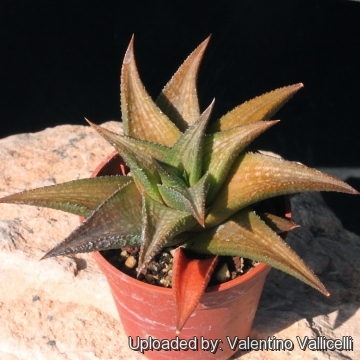
Haworthia tessellata var. inflexa Photo by: Valentino Vallicelli
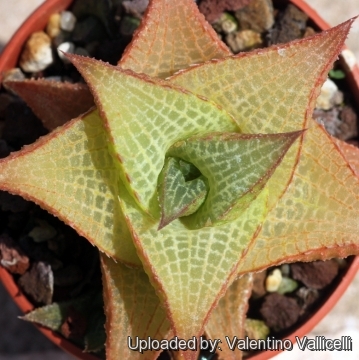
Haworthia tessellata var. inflexa Photo by: Valentino Vallicelli
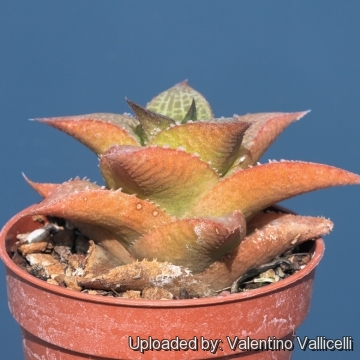
Haworthia tessellata var. inflexa Photo by: Valentino Vallicelli
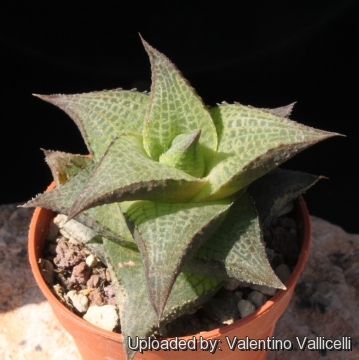
Haworthia tessellata var. inflexa Photo by: Valentino Vallicelli
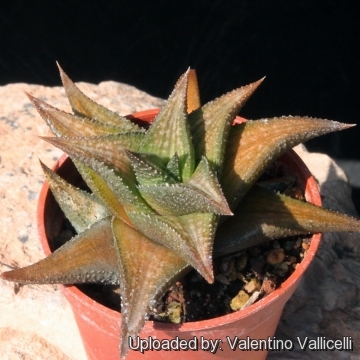
Haworthia tessellata var. inflexa Photo by: Valentino Vallicelli
Send a photo of this plant.
The gallery now contains thousands of pictures, however it is possible to do even more. We are, of course, seeking photos of species not yet shown in the gallery but not only that, we are also looking for better pictures than those already present. Read More...
The gallery now contains thousands of pictures, however it is possible to do even more. We are, of course, seeking photos of species not yet shown in the gallery but not only that, we are also looking for better pictures than those already present. Read More...
| Your Actions | |
|---|---|
| Back to Haworthia index | |
| Back to Aloaceae index | |
 |
Back to Succulents Encyclopedia index |








